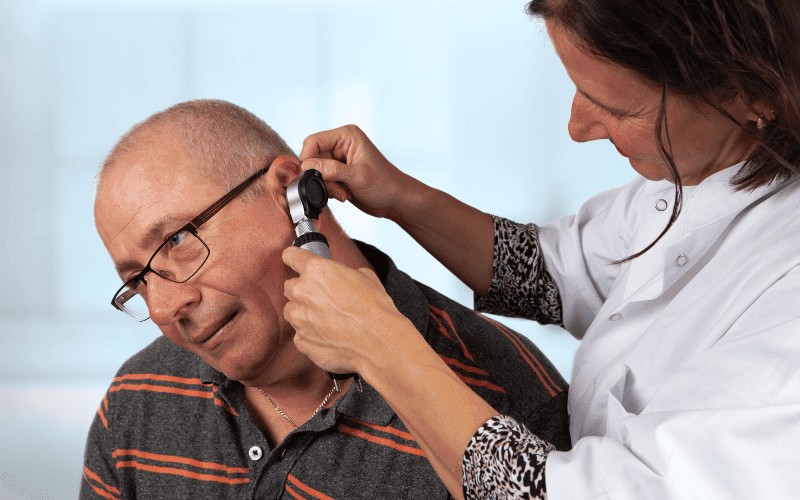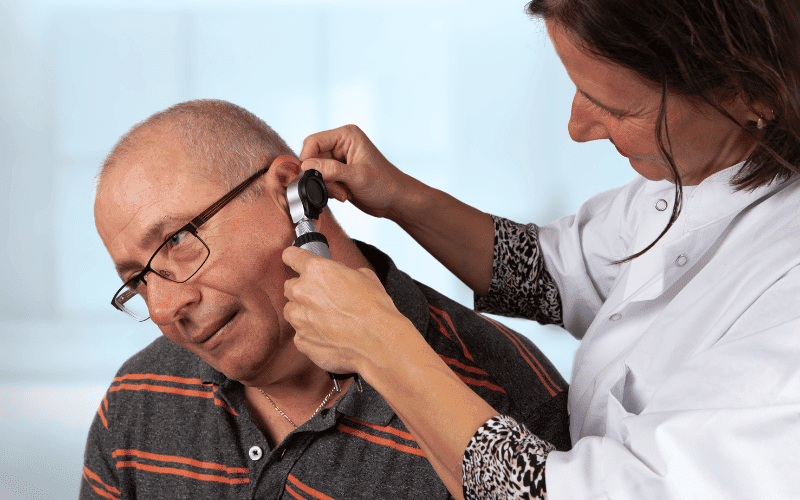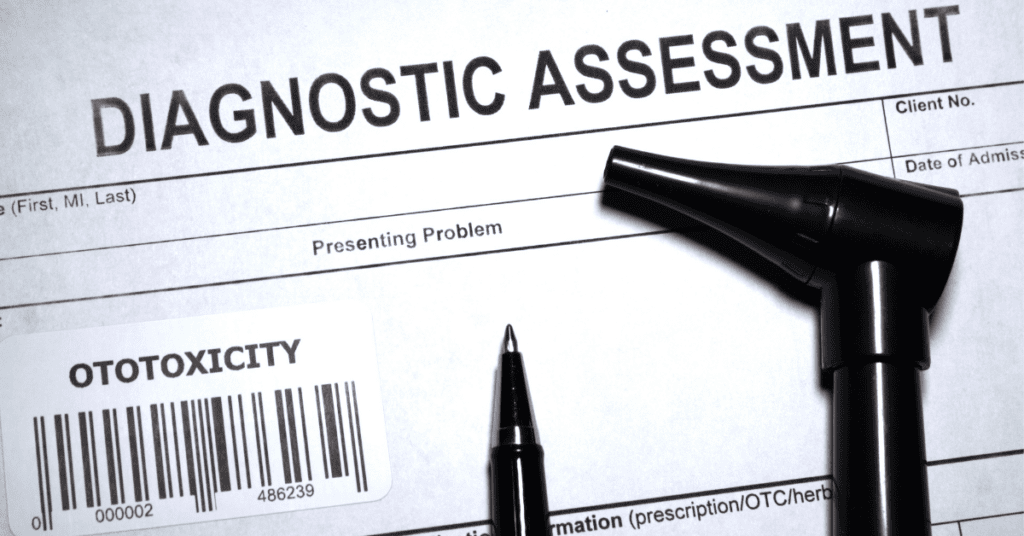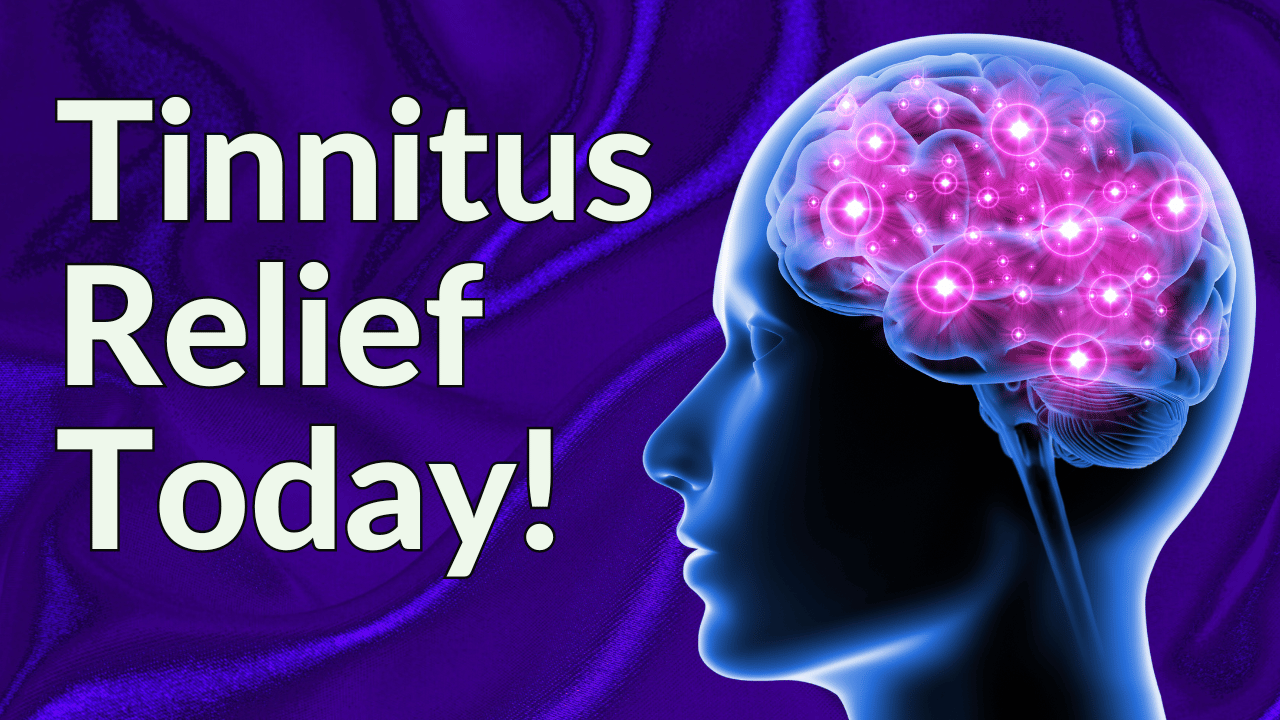Our ear, like any other body part, is susceptible to damage from exposure to chemicals and other environmental elements. Ototoxicity is a medical term used to describe ear poisoning, or damage-causing exposure. “Oto” means ear and “toxicity” means poisoning, literally translating to ear poisoning. Despite its literal name, ototoxicity develops when a person develops a hearing or balance disorder from coming into contact with a medicine or other chemical exposure. Understanding what ototoxicity is, what the signs of ototoxicity are, and what to do if you suspect ototoxic exposure can help prevent hearing loss and damages to the inner ear. So what is ototoxicity, exactly?
"Treble Health is a beacon of hope - they helped me to significantly reduce my tinnitus volume and awareness within just a few short months."


"Treble Health is a beacon of hope - they helped me to significantly reduce my tinnitus volume and awareness within just a few short months."
– Melinda
Schedule a free consultation to learn which Treble Health solution is right for you. Join Melinda and thousands more who have found lasting tinnitus relief.
Book a free consultation to learn which Treble Health solution is right for you. Join Melinda and thousands more who have found lasting tinnitus relief.
What Should You Know About Ototoxicity?
Ototoxicity does not always come from the sources you might expect. While most people know that hearing and balance issues can occur as a result of hearing loss, and hearing loss can be linked to damages to the structures of the inner ear, caused by infection, injury, and exposure to loud noises, many people are unfamiliar with the reality of ototoxic exposures and resulting ototoxic hearing loss.
As of the time of this writing, there are more than 200 known ototoxic medications, or medications known to potentially harm the inner ear or auditory nerve, leading to potential hearing loss and subsequent balance problems. The list is full of prescription medications and over the counter medications alike, many of which may already be sitting in your medicine cabinet at home.



Ototoxicity can be found in people of all ages, ranging from newborn infants to the elderly. If exposure is suspected, a monitoring protocol is recommended to monitor for any harmful effects on the hearing and balance organs. Hearing and balance symptoms can quickly point to the presence of an ototoxic medication or chemical.
Ultimately, ototoxic medications and exposures can lead to hearing loss, tinnitus, and balance problems. In some cases, stopping the exposure or medication will result in a reversal of inner ear symptoms or hearing loss. In others, the damage is considered permanent, and hearing loss cannot be fully improved upon or outright reversed.
What Happens In Ototoxicity?
To fully answer “what is ototoxicity,” it is important to delve into exactly how damage to the inner ear structures (hair cells and/or auditory nerve fibers) occurs, or how poisoning these structures occurs. In ototoxicity, the inner ear is essentially poisoned by certain chemicals or compounds within medication, which causes a breakdown of cells within the inner ear (or cochlea). The damage means that these structures are not able to capture and transmit information to the brain in order to properly process auditory nerve and vestibular rehabilitation (or balance rehabilitation). The result is hearing and balance issues. While hearing and balance may not initially appear to be related, the auditory system is directly responsible for proper balance function.
The amount of damage incurred to delicate inner ear structures is not a given; instead, the extent of the damage depends on several important factors. These include:
- The type of medication. Different medications affect the inner ear differently. Some are only slightly harmful, while others deliver a serious punch.
- The dosage used or exposed to. Lower-dosage medications and lower exposures do not damage the inner ear as much, and subsequently do not lead to as significant a rate of hearing loss and related conditions.
- The duration of exposure/use. Some ototoxic medications and chemicals are only used in short bursts, which makes them less likely to cause permanent hearing loss or permanent damage to the auditory nerve.
Damage to the ear canal and resulting balance problems can cause significant distress, so if you experience ototoxicity in response to chemical use or medication exposure, be sure to speak with your healthcare professional for further evaluation and a discussion of risk factors.
Signs And Symptoms of Ototoxicity
The signs and symptoms of ototoxicity can show up suddenly, or can come on gradually. In some cases, symptoms can be delayed as many as 5 years following exposure. This can make finding the source of sensorineural hearing loss difficult, particularly if the serious illness, exposure, or medication were diagnosed and treated many years prior to symptom onset. Fortunately, there are risk factors and warning signs to look out for to detect hearing and balance problems early to have ototoxicity diagnosed early on. The first sign is frequently tinnitus, or ringing in the ears, a response to some hearing damage. Following the onset of this condition, you may experience:
- Hearing loss. You may experience profound hearing loss or mild hearing loss and balance problems, but most experience difficulty hearing soft sounds, speech sounds, or high-frequency sounds. These can all indicate the presence of hearing loss. Other signs include frequently having to ask “what?”; lip reading; turning the volume up high on the radio and TV, little to no startle reflex (in babies), inattention (in children), and delayed or absent speech in children.
- Balance problems. Balance problems can be minimal or severe, though both minimal and severe cases typically exhibit difficulty maintaining stable body posture and feeling dizzy or lightheaded. Other signs include difficulty remaining upright, walking in a straight line, climbing stairs, stepping off curbs, walking in dim or low-lit places, and frequent falling, recurrent headaches, and a general feeling of dizziness or lightheadedness.
What Causes Ototoxicity?
Over 200 medications are currently recognized as having ototoxic properties, which causes harm to the inner ear structures. Why, then, are these medications still available? Many ototoxic medications are considered essential, meaning that their benefits outweigh the risk of ototoxicity. They are often medications administered for conditions such as infection control and cancer treatment. Although some OTC products are ototoxic, they typically only pose a threat at dosage amounts that exceed recommendations. The most common ototoxic medication options include:
Aminoglycoside Antibiotics
Used to treat severe bacterial infections–often through intravenous injections (called IV antibiotics), these medications include gentamicin, vancomycin, and neomycin. They are most frequently used to treat bacterial infections during hospitalization.
Chemotherapy Drugs
Chemotherapy medications have an important job: destroying malignant cells within the body. Nevertheless, they are known to wreak havoc on other, healthy parts of the body, including the inner ear. The two most commonly used chemotherapy medications with a history of ototoxicity include cisplatin and carboplatin. Cisplatin induced hearing loss is a recognized issue, and using these medications is among the risk factors for having ototoxicity diagnosed.
Loop Diuretics (Water Pills)
Diuretics in general are not all ototoxic; however, LOOP diuretics have been studied and found to have ototoxic properties when used for a prolonged period or in high doses. It may be due to the similarities between inner ear structures and kidney structures, and the way the two interact with and influence one another. Possible ototoxic diuretics include bumetanide (Bumex), furosemide (Lasix), torsemide (Demadex), and ethacrynic acid.
Malaria Treatments
While not terribly common in the U.S., those traveling to countries where malaria is common, or those who live in countries where malaria is common may need malaria treatment. The most common medication to treat malaria is Quinine, which is known to be ototoxic. Because malaria can be deadly, the risk of ototoxicity and subsequent hearing and balance problems is considered a lesser issue than that of contracting or continuing to be infected by malaria.
Over The Counter Medications



Many OTC products have the potential to be ototoxic in large doses, or doses larger than recommended on the medication’s written instructions. Salicylates such as aspirin are the most commonly reported OTC medications linked to ototoxicity, and large doses are frequently related to reports of hearing loss and tinnitus.
Environmental Substances and Chemicals
Many common chemicals and environmental substances found in and around our homes have ototoxic properties. These include mercury, tin, lead, carbon monoxide, toluene, manganese, butyl nitrite, hexane, styrene, xylene, carbon disulfide, and trichloroethylene. While most of these names are long and complicated, they can be found in cooking materials, building materials, and far more.
Current Practices In Ototoxicity Monitoring
If your healthcare provider prescribes you a well-known ototoxic medication, they may also put you on an ototoxicity monitoring program to keep an eye on symptoms and increase the likelihood of the early detection of any changes to hearing or balance. Typically, newborn infants in the Neonatal Intensive Care Unit (NICU) and those being given chemotherapy medications are the individuals most likely to be put on a monitoring program. This is because both of these populations are frequently administered high doses of ototoxic medications on a frequent basis. Testing ensures the doses are not causing harm to the structures of the ear.
According to the American Academy of Audiology (AAA)’s Statement and Practice Guidelines on Ototoxicity Monitoring, weekly or biweekly monitoring is recommended for aminoglycoside antibiotics. Because aminoglycosides can also cause delayed hearing loss, follow-up testing should also be scheduled a few months after drug discontinuation.
Similarly, patients receiving chemotherapy drugs frequently experience ototoxicity in the form of tinnitus, high-frequency hearing loss, and balance problems. Patients will receive a baseline hearing test prior to receiving chemotherapy treatment, which can then be evaluated against repeat hearing testing to evaluate the presence of significant hearing impairment. The AAA states that, “Follow-up evaluations then should occur just prior to each course of platinum-based chemotherapy, after any temporary threshold shift has had time to recover, and before the patient is connected to intravenous lines or monitoring equipment. This schedule will also allow patients to be tested when they are feeling at their best, thus, providing more reliable behavioral responses. Because platinum-based chemotherapy can cause delayed or progressive hearing loss, a followup test should also occur a few months after chemotherapy treatment is completed. Generally this can be coordinated with a medical follow-up visit. If the patient also received head and neck radiation, monitoring for the next year or two is advisable, because hearing loss may continue to progress in such cases.”
How Is Ototoxicity Treated?
Fortunately, impairments to balance function that stem from ototoxicity can be mitigated through specialized physical therapy and comprehensive vestibular rehabilitation programs. These targeted therapies are conducted by healthcare professionals who are extensively trained in techniques to assist individuals in retraining their bodies to maintain balance, even when the auditory system has been compromised or the ear canal is not functioning properly. By focusing on improving the function of balance, patients can experience a significant enhancement in their overall quality of life. Furthermore, by addressing these balance issues proactively, it is possible to reduce the risk of secondary complications that might arise due to a lack of stability and increase the likelihood of a safer, more independent future for those affected by ototoxicity.



Research is continually searching for ways to reverse permanent hearing loss, but at present, there is not a sure way to reverse damage incurred by ototoxic exposure. While it is not always possible to stop taking certain medications solely due to their ototoxic properties, it is important to connect with a licensed hearing professional who can monitor the effects of ototoxicity, and subsequently help to manage any accompanying symptoms. Licensed hearing professionals, such as the audiologists at Treble Health, can help address hearing loss resulting from ototoxicity in a variety of ways. If you are experiencing hearing loss or tinnitus related to ototoxicity, we encourage you to schedule a complimentary telehealth consultation with our team. During this free, 20-minute Zoom call, you can speak with an audiologist on our team to voice any concerns, ask any questions that you may have, and learn about viable treatment options specific to your situation. Our audiologists have decades of experience in treating both hearing loss and tinnitus, and can help to guide you through this process. Click here to schedule your complimentary consultation.
Next Step: Book Free Consultation
- 75% of patients reduced their tinnitus within three months after following our recommendations.
- "I feel like Treble Health literally gave me my life back." - Randy S. (verified customer)
- Join thousands of people who have reduced their tinnitus after scheduling a free consultation.


















